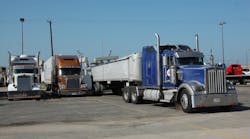The 27th annual State of Logistics report confirmed this week something many trucking companies know all too well: freight declined precipitously between the state of 2015 and 2016, by as much as 15% in the case of the dry van sector, partly due to a “flattening” of truck tonnage last year following a 7% gain in 2014.
Yet Sean Monahan, the report’s author and a logistics expert with A.T Kearney, noted that while economic and motor carrier conditions are expected to keep favoring a “shipper’s market” over the next six months, a realignment of factors – including capacity, inventories, interest rates, and economic growth – are projected to result in moderately higher transportation rates in 2017.
The annual State of Logistics report – published by the Council of Supply Chain Management Professionals (CSCMP) and presented by Penske Logistics – highlighted a mix of factors that are generating both positive and negative effects for different sectors of the trucking industry:
- Despite softening demand and lower rates, competition for drivers is intense. Though Bureau of Labor Statistics (BLS) data indicates annual driver wages only increase 2% between 2010 and 2015, Monahan believes those numbers “do not tell the whole story” as his interviews with TL carriers indicates wages are being raised higher than that average.
- Dedicated fleets are being characterized as a “bright spot” for motor carriers and an area of “increased importance” for shippers.
- LTL carriers in general report “stable pricing,” with overall revenues increasing 7% over the past year as many LTL carriers are now investing in dimensional scanning devices to help “maintain price discipline.”
- Trucking markets with “specialized” equipment, especially liquid bulk and flatbed operators, are week. According to Truckstop.com data, flatbed rates declined 11% from Jan. 2015 through April this year, with rates for other “specialized” carriers falling 17% over the same period.
- Brokerage services are “thriving,” in Monahan’s words, due to the “softness” in the motor carrier market, though he cautioned that may be more of a short-term phenomenon versus a “new normal.”
Though he concurred with International Monetary Fund (IMF) projections made back in April for U.S. gross domestic product (GDP) growth of 2.4% for this year and 2.5% for 2017 – indicating what “degree of post-recession stability” – Monahan stressed that “uncertainty remains on several fronts” with the U.S. economic recovery continuing to be “tenuous and susceptible to domestic and global factors” with oil prices in particular increasingly showing signs of upward pressure.
“How these trends evolve in 2016 will largely determine the state of logistics for the coming year,” he added.



